Venomous Snakes of Texas
Texans are no strangers to snakes, especially during the summertime when many of them are out and about. Copperhead, Coral, Cottonmouth, and Rattler: these are the names given to the four species of venomous snakes in Texas. It is a good idea to educate others as well as yourself about these snakes, and how to avoid them as best as possible.
“Snakes tend to follow their food source,” said Teresa Shisk-Saling RVT, Veterinary Technician at the Texas A &M College of Veterinary Medicine and Biomedical Sciences. “If you have problems with snakes in your home area make sure to clean up any trash, debris, wood piles, rock piles, or building material laying on the ground.”
Shisk-Saling continued, “Last summer when it was very hot out, a friend of mine had a problem with copperheads in her dog kennels so she took several litter pans and placed them along her fence line and kept them full of water. After that, there were no more snakes in the kennels because they were just looking for water, problem solved.”
Broad Banded Copperhead
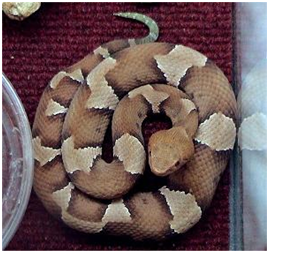
Out of these four snakes, the Copperhead is the most prevalent in the Bryan/College Station area. They will mostly eat rodents and belong to the Pit Viper family. This makes them unique in that they have a pit located between the eye and the nostril on either side of the head. These openings house a pair of extremely sensitive infrared detecting organs, which in effect give the snakes a sixth sense that helps them to find and perhaps even judge the size of the small warm-blooded prey. They can look very similar to the Water Moccasin, and are sometimes referred to as the Land Moccasin. In general, you want to be cautious around downed/decaying trees, rock cuts, and sheet metal lying on the ground, trash, rock or wood piles.
Coral Snake
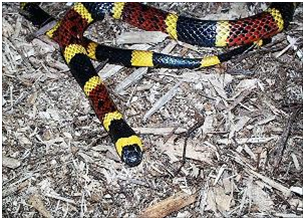
This snake is not to be confused by the similar colored and non-venomous Milk Snake, whose red and black bands connect. Remember “Red and Yellow kills a fellow, Red and Black is a friend to Jack.” Mostly the coral snakes in the eastern part of the state eat snakes and those in western part eat lizards. They tend to be very shy and secretive and will spend most of their time underground, in deep leave litter, dens and burrows. There is no anti-venom being manufactured in the United States that is available for people bitten by this snake. They possess the most potent venom out of any North American snake, but thankfully account for less than one percent of the number of annual snake bites. Respiratory paralysis can occur suddenly or within hours after a coral snake bite, therefore intubation and ventilation should be employed in a victim in anticipation for this.
Western Diamondback Rattlesnake
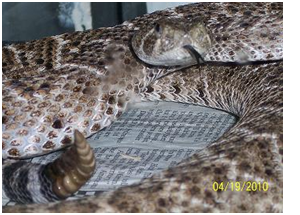
Another member of the Pit Viper family, these snakes primarily eat rabbits or other small mammals. You can find them mostly south and west of the Bryan/College Station area and are likely hear them before you see them. There are a number of snakes, venomous and non-venomous, that will beat their tail in grass and leaf litter trying to sound like a Rattlesnake. These snakes are a little more aggressive and will rarely back away from confrontation so it is best to always steer clear.
Water Moccasin (Cotton Mouth)
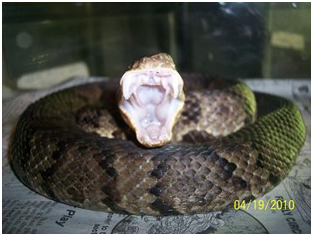
These semi-aquatic Pit Vipers eat fish and frogs. All snakes swim on top of the water, however when they stop to rest or evaluate their surroundings venomous snakes will continue to float on top of the water and non-venomous will sink to where only their head will be visible.
(Below: the non-venomous Yellow-Belly Watersnake)
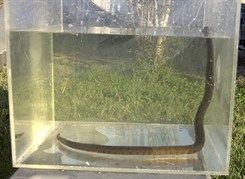
(Below: the venomous Water Moccasin)
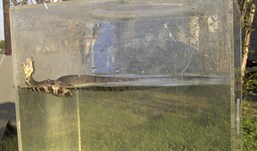
When Water Moccasins feel threatened they will stand their ground and flatten their bodies out to make themselves appear bigger. Also, they will hiss and gape their mouths open, revealing the lighter colored tissue in their mouth, hence their name.
Occasionally, you will find a snake stretched out warming itself in a sunny area; just leave the snake alone and respect their space if you are going to continue admiring it. These four snakes, as well as most snakes, act more on the defense than offence.
“One of my favorite statistics is that 98 percent of snake bites happen to males between the ages of 18 and 28 and alcohol is also involved,” said Shisk-Saling.
“Despite urban myth, these snakes do not chase people. This is not to say that you may be standing between the snake and their hiding place (den, cubby hole, etc.); giving them a reason to head your direction,” said Shisk-Saling
The underbelly of a snake is very sensitive to vibration which helps them to sense any other animals approaching.
About 20 percent of venomous snake bites in people are “Dry” (non-envenomated) bites, but if you are bitten it is always good to be checked out by a doctor regardless.
“If a person is bitten and envenomated by a snake they will know it, because the pain will be immediate and intense. The most important thing is to stay calm and remember the steps that you need to take following the bite,” explained Shisk-Saling.
Anti-venom binds to and neutralizes the venom that the snake has injected into you, halting any further damage, but does not reverse damage already done. Thus, it should be administered as soon as possible.
“Do not waste time trying to locate the snake. If it is a venomous snake bite, the bite pattern will be very different from a non-venomous snake,” said Shisk-Saling.
“Go immediately to the nearest medical facility and call ahead to let them know that you are coming; Not every emergency room carries anti venom, but they should have the expertise to stabilize the bite and take the necessary action,” said Shisk-Saling. “Some ERs have nurses and doctors that have experience and knowledge about how to treat snake bites.”
Another reason not to pretend like you are Jeff Corwin off of Animal Planet is the fact that anti-venom is not always easy to come by, if available at all, and is EXTREMELY expensive.
“Do not apply a tourniquet, ice, or heat and if possible lower the bitten area below the heart while someone else drives,” advised Shisk-Saling.
So remember, snakes are not evil creatures seeking to attack innocent people, even the venomous ones. So if you are in a snake’s home territory, leave it alone. If the snake is in your territory, unless it poses an immediate threat, leave it alone, it will move on, so that you can as well.
ABOUT PET TALK
Pet Talk is a service of the College of Veterinary Medicine & Biomedical Sciences, Texas A&M University. Stories can be viewed on the Web at vetmed.tamu.edu/news/pet-talk. Suggestions for future topics may be directed to editor@cvm.tamu.edu.
Pictures provided by Teresa Shisk-Saling RVT, Veterinary Technician at the Texas A &M College of Veterinary Medicine and Biomedical Sciences.


